Family: Tenthredinidae
Family common name: common sawflies
Subfamily: Selandriinae
Tribe: Aneugmenini
Genus: Aneugmenus Hartig, 1937
Subgenera: none
The Tenthredinidae are the most species-rich family and are found throughout the world, in all continents but Antarctica. They are known as the “common sawflies.” They can generally be recognized by a cylindrical body and long, segmented antennaeantenna:
the sensory organ emerging from the front of the head, usually between the compound eyes and above the clypeus; includes the flagellum, scape and pedicel
 . Otherwise, they come in a variety of colors, sizes, and forms (Goulet 1992Goulet 1992:
. Otherwise, they come in a variety of colors, sizes, and forms (Goulet 1992Goulet 1992:
Goulet H. 1992. The genera and subgenera of the sawflies of Canada and Alaska: Hymenoptera. Symphyta. The insects and arachnids of Canada. Part 20. Agriculture Canada Publication.).
Sawflies in the Selandriinae subfamily are relatively small and slender. The range of Selandriinae is worldwide; it occurs on all continents except Antarctica (Goulet 1992Goulet 1992:
Goulet H. 1992. The genera and subgenera of the sawflies of Canada and Alaska: Hymenoptera. Symphyta. The insects and arachnids of Canada. Part 20. Agriculture Canada Publication.). It is the most common and diverse group of tenthredinids in tropical regions, particularly in Central America, South America, and Southeast Asia (Smith 1969eSmith 1969e:
Smith DR. 1969e. Nearctic Sawflies. II. Selandriinae: Adults (Hymenoptera: Tenthredinidae). Technical Bulletin, U.S. Department of Agriculture 1398: 1-48.). Selandriinae contains the only known sawflies that feed on non-vascular plants, specifically ferns (Smith et al. 2013Smith et al. 2013:
Smith DR, Janzen DH and Hallwachs W. 2013. Food plants and life histories of sawflies of the families Argidae and Tenthredinidae (Hymenoptera) in Costa Rica, a supplement. Journal of Hymenoptera Research 35: 17-31. https://doi.org/10.3897/JHR.35.5496). The subfamily can be distinguished from other subfamilies by wing venationvenation:
the network of veins on a wing
(Goulet 1992Goulet 1992:
Goulet H. 1992. The genera and subgenera of the sawflies of Canada and Alaska: Hymenoptera. Symphyta. The insects and arachnids of Canada. Part 20. Agriculture Canada Publication.).
Aneugmenus are small, about 5 mm in length and mostly black. The genus is a fern-feeding sawfly with some unique behaviors (Smith 1969eSmith 1969e:
Smith DR. 1969e. Nearctic Sawflies. II. Selandriinae: Adults (Hymenoptera: Tenthredinidae). Technical Bulletin, U.S. Department of Agriculture 1398: 1-48., Smith 2003).
There are 32 described extantextant:
in existence; opposite of extinct
species worldwide. Seven species occur in North America (Taeger et al. 2010Taeger et al. 2010:
Taeger A, Blank SM, and Liston AD. 2010. World Catalog of Symphyta (Hymenoptera). Zootaxa 2580: 1-1064.).
A key to NearcticNearctic:
describing the region of the Northern Hemisphere that includes North America south through northern Mexico
 species is included in Smith 1969eSmith 1969e:
species is included in Smith 1969eSmith 1969e:
Smith DR. 1969e. Nearctic Sawflies. II. Selandriinae: Adults (Hymenoptera: Tenthredinidae). Technical Bulletin, U.S. Department of Agriculture 1398: 1-48..
Subfamily characters
 vein Rs+M curved near intersection with veinvein:
vein Rs+M curved near intersection with veinvein: Sc+R (Smith 1969eSmith 1969e:
Sc+R (Smith 1969eSmith 1969e: vein M meeting Sc+R basalbasal:
vein M meeting Sc+R basalbasal: veins M and m-cu about parallel (Smith 1969eSmith 1969e:
veins M and m-cu about parallel (Smith 1969eSmith 1969e: vein 2r-m present (Goulet 1992Goulet 1992:
vein 2r-m present (Goulet 1992Goulet 1992:Genus characters
 as wide as long (Smith 1969eSmith 1969e:
as wide as long (Smith 1969eSmith 1969e: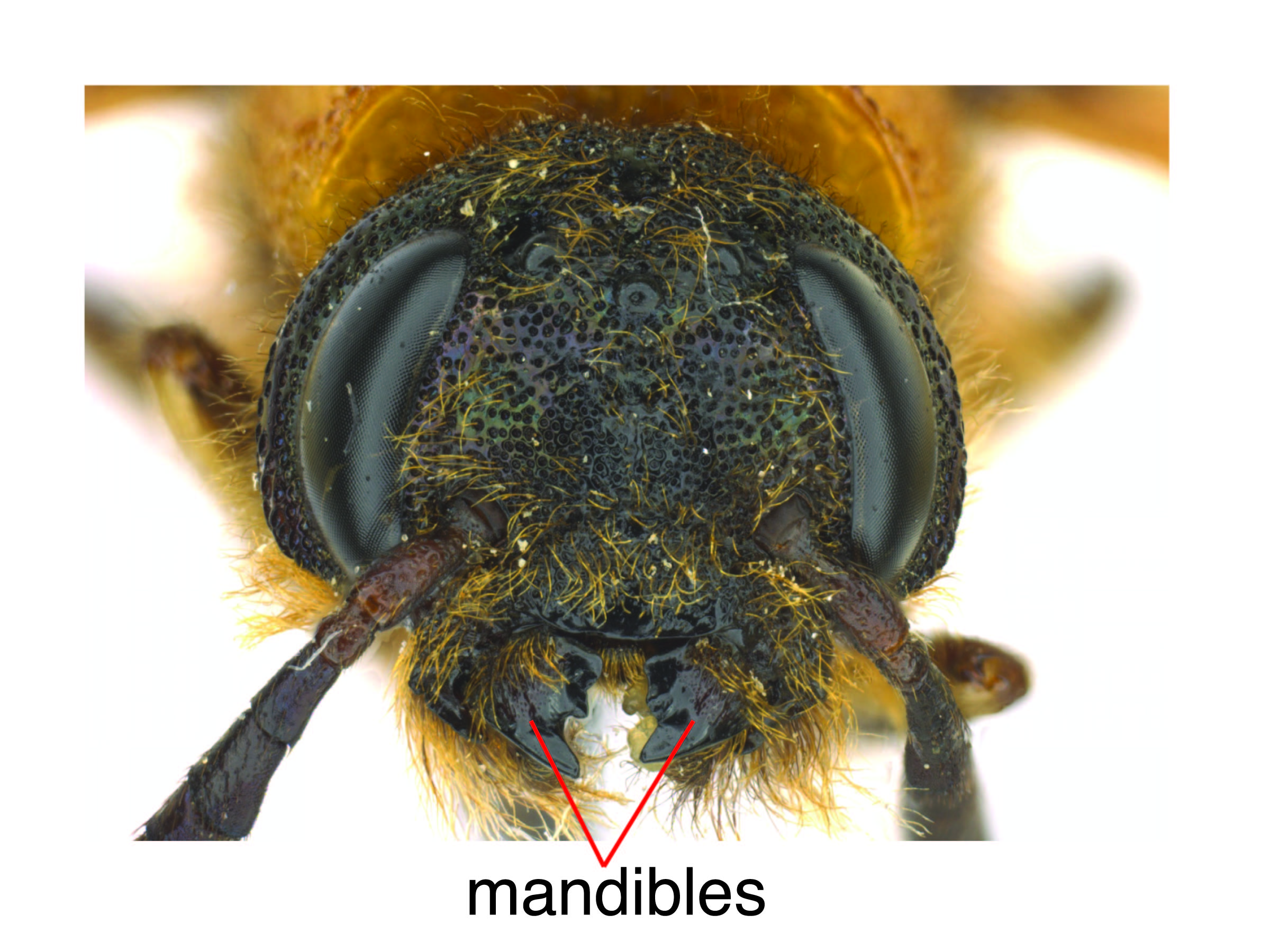 ; not always extending to top of compound eye (Goulet 1992Goulet 1992:
; not always extending to top of compound eye (Goulet 1992Goulet 1992: anal crossveinanal crossvein:
anal crossveinanal crossvein: anal cellanal cell:
anal cellanal cell: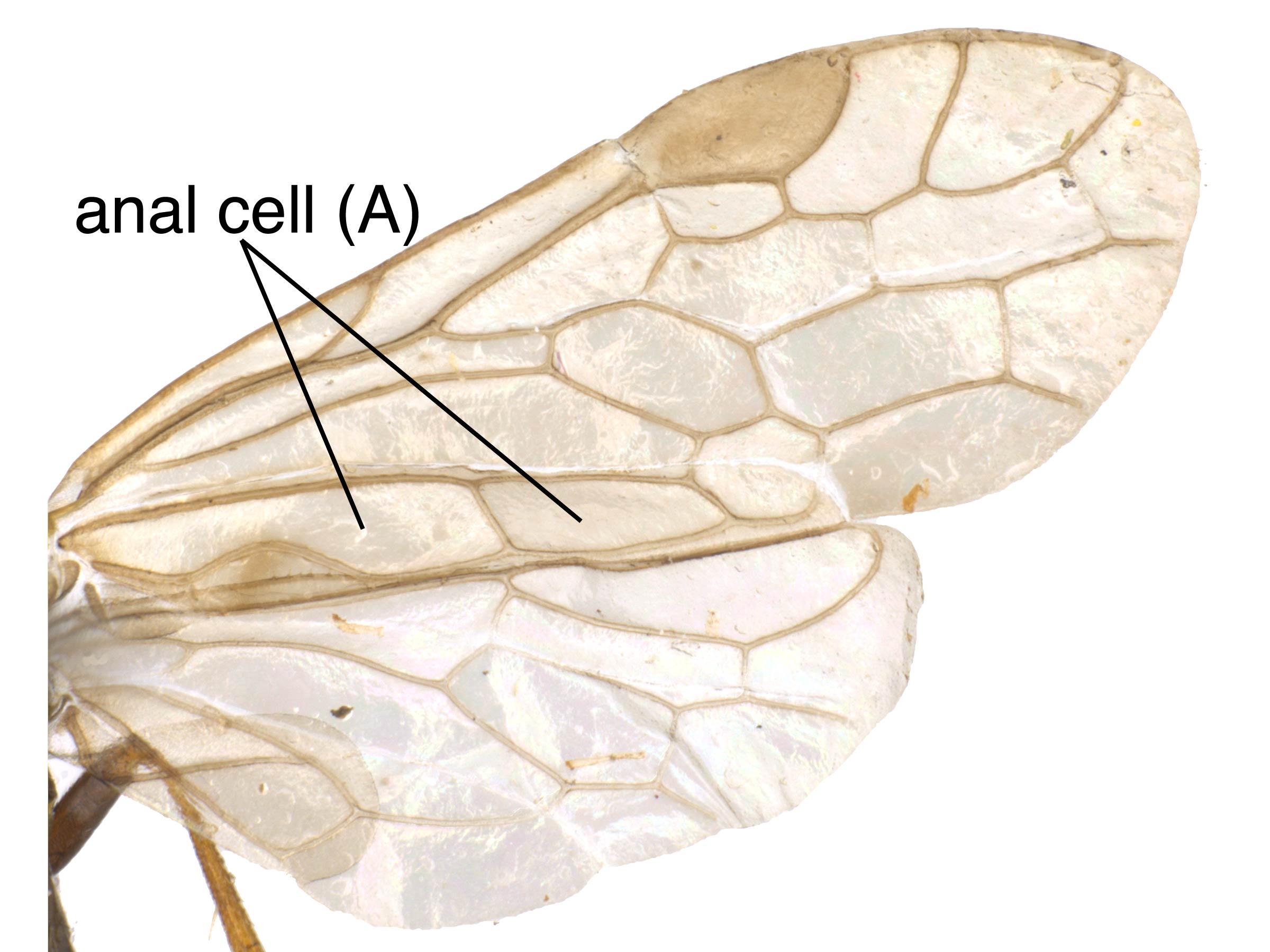 lacking petiolepetiole:
lacking petiolepetiole: flat with margin straight or slightly emarginated (Smith 1969eSmith 1969e:
flat with margin straight or slightly emarginated (Smith 1969eSmith 1969e: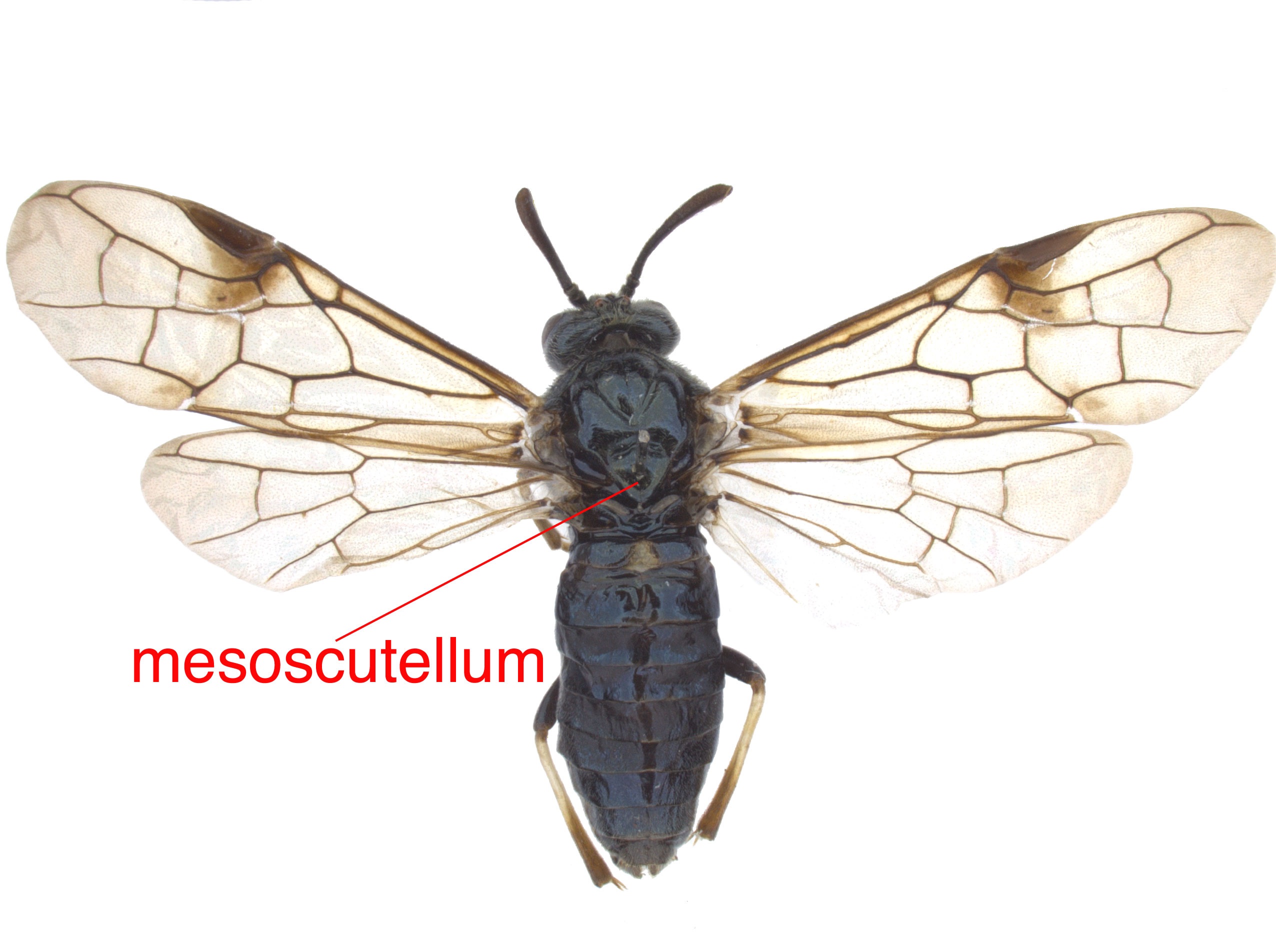 with pits (Goulet 1992Goulet 1992:
with pits (Goulet 1992Goulet 1992: with small inner tooth and distinct, round basalbasal:
with small inner tooth and distinct, round basalbasal:Aneugmenus can be confused with similar species in the subfamily Selandriinae or tribe Aneugmenini. It can be distinguished from most other genera by the absence of a fore wingfore wing:
the anterior wing of each pair of wings; usually the largest wing of the pair
 anal crossveinanal crossvein:
anal crossveinanal crossvein:
a crossvein that goes through the center of the basal anal cell
and from closely related Birka and Nesoselandria by the occipitalocciput:
the posterior surface of the head
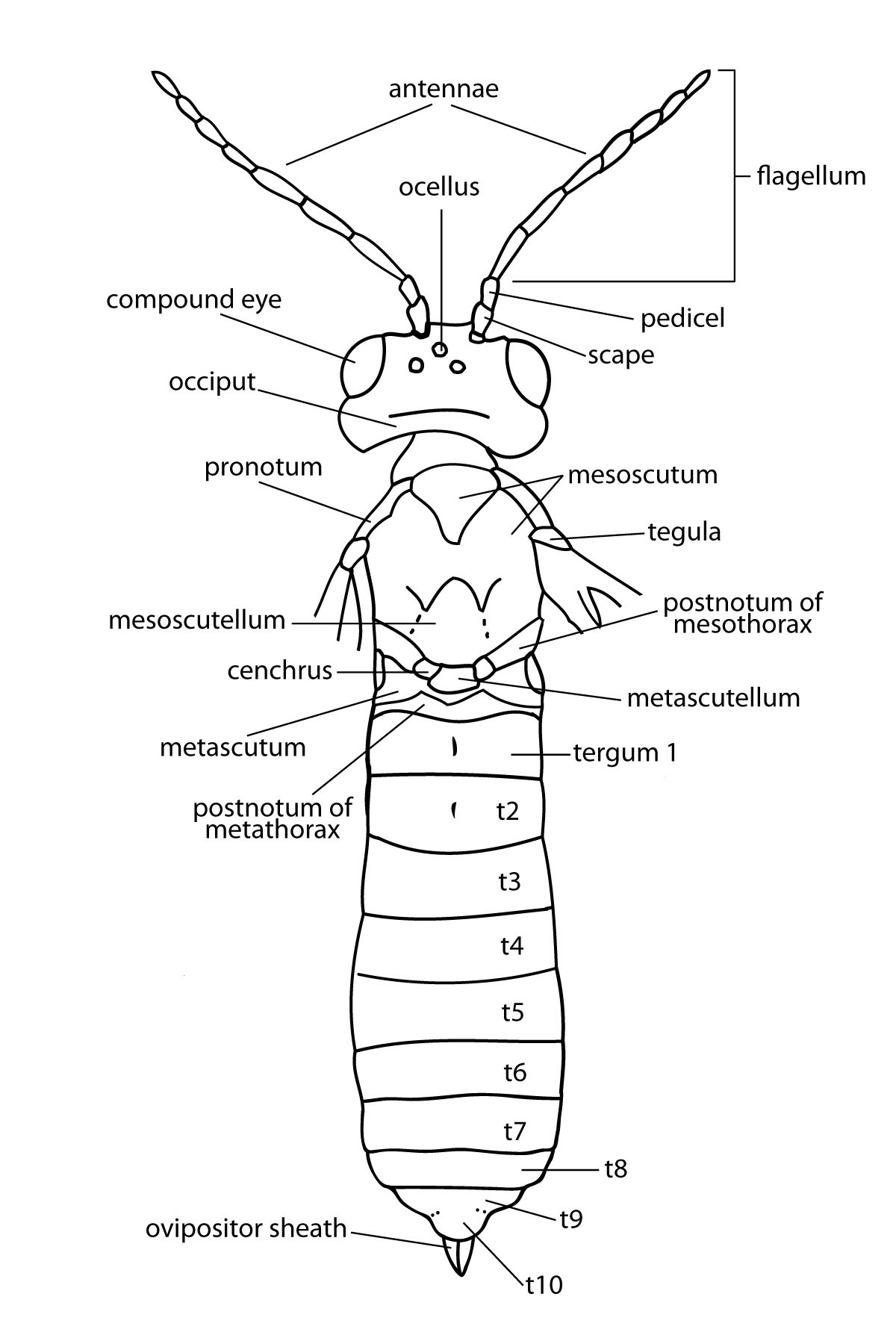 ridge and pitted mesoscutellummesoscutellum:
ridge and pitted mesoscutellummesoscutellum:
the anterior section of the scutellum
 (Smith 1969eSmith 1969e:
(Smith 1969eSmith 1969e:
Smith DR. 1969e. Nearctic Sawflies. II. Selandriinae: Adults (Hymenoptera: Tenthredinidae). Technical Bulletin, U.S. Department of Agriculture 1398: 1-48.).
none
In North America, Aneugmenus feeds on Pteridium aquilinum (bracken fern) (Smith 1969eSmith 1969e:
Smith DR. 1969e. Nearctic Sawflies. II. Selandriinae: Adults (Hymenoptera: Tenthredinidae). Technical Bulletin, U.S. Department of Agriculture 1398: 1-48.).
Larvaelarva:
the immature stage of holometabolous insects
 feed on the underside of the leaves. At maturity, the prepupae drop to the ground to overwinter in the soil (Boevé and Schaffner 2003Boevé and Schaffner 2003:
feed on the underside of the leaves. At maturity, the prepupae drop to the ground to overwinter in the soil (Boevé and Schaffner 2003Boevé and Schaffner 2003:
Boevé JL and Schaffner U. 2003. Why does the larval integument of some sawfly species disrupt so easily? The harmful hemolymph hypothesis. Oecologia 134: 104–111. https://doi.org//10.1007/s00442-002-1092-4).
Non-native A. padi was likely introduced from Europe or western Asia and is now established in the Pacific Northwest. It is recorded as parthenogenetic:
in North America, and as such, no male is known (Smith 1969eSmith 1969e:
Smith DR. 1969e. Nearctic Sawflies. II. Selandriinae: Adults (Hymenoptera: Tenthredinidae). Technical Bulletin, U.S. Department of Agriculture 1398: 1-48.).
Aneugmenus padi and some other Aneugmenus spp. larvaelarva:
the immature stage of holometabolous insects
 in Europe, and A. merida in Venezuela have defensive behaviors to limit predaceous ants that live on bracken fern to feed on extra-floral nectaries (Heads and Lawton 1985Heads and Lawton 1985:
in Europe, and A. merida in Venezuela have defensive behaviors to limit predaceous ants that live on bracken fern to feed on extra-floral nectaries (Heads and Lawton 1985Heads and Lawton 1985:
Heads PA and Lawton JH. 1985. Bracken, ants, and extrafloral nectaries. III. How insect herbivores avoid ant predation. Ecological Entomology 10: 29-42., Naya et al. 2016Naya et al. 2016:
Naya M, Avila-Nuacute;ntilde;ez JL, and Calcagno-Pissarelli MP. 2016. Haemolymph [sic] defense capacity of the Neotropical sawfly Aneugmenus merida against ant predation. Journal of Insect Behavior 29 (4): 459-472.). When a larvalarva:
the immature stage of holometabolous insects
 is first cut by an attacking ant, it bleeds out hemolymphhemolymph:
is first cut by an attacking ant, it bleeds out hemolymphhemolymph:
the "blood" of an insect, a fluid plasma containing nucleated cells
that is extremely sticky and distasteful to the ants. The larvaelarva:
the immature stage of holometabolous insects
 usually can heal after the initial attack, and the associated ants do not return (Heads and Lawton 1985Heads and Lawton 1985:
usually can heal after the initial attack, and the associated ants do not return (Heads and Lawton 1985Heads and Lawton 1985:
Heads PA and Lawton JH. 1985. Bracken, ants, and extrafloral nectaries. III. How insect herbivores avoid ant predation. Ecological Entomology 10: 29-42.). Bracken fern is toxic to many animals, but it is unclear if the distastefulness of the sawfly’s hemolymphhemolymph:
the "blood" of an insect, a fluid plasma containing nucleated cells
is due to compounds bio-accumulated from the host plant (Naya et al. 2016Naya et al. 2016:
Naya M, Avila-Nuacute;ntilde;ez JL, and Calcagno-Pissarelli MP. 2016. Haemolymph [sic] defense capacity of the Neotropical sawfly Aneugmenus merida against ant predation. Journal of Insect Behavior 29 (4): 459-472.).
Because of the toxic properties and commonality of bracken fern, land managers in the United Kingdom have tried to control its growth. Aneugmenus padi was considered as a potential biocontrol insect due to its ability to heavily damage the plant from feeding behaviors. However, the damage was not sufficient to prevent fern re-growth (Lawton 1988Lawton 1988:
Lawton JH. 1988. Biological control of bracken in Britain: constraints and opportunities. Philosophical Transactions of the Royal Society of London 318: 335-355.).
A unique adult behavior, known by some authors as “nuptial feeding,” is recorded in A. flavipes. A female was observed attaching her mouthparts to a modified gland of the male’s seventh tergitetergite:
a sclerotized segment of the tergum
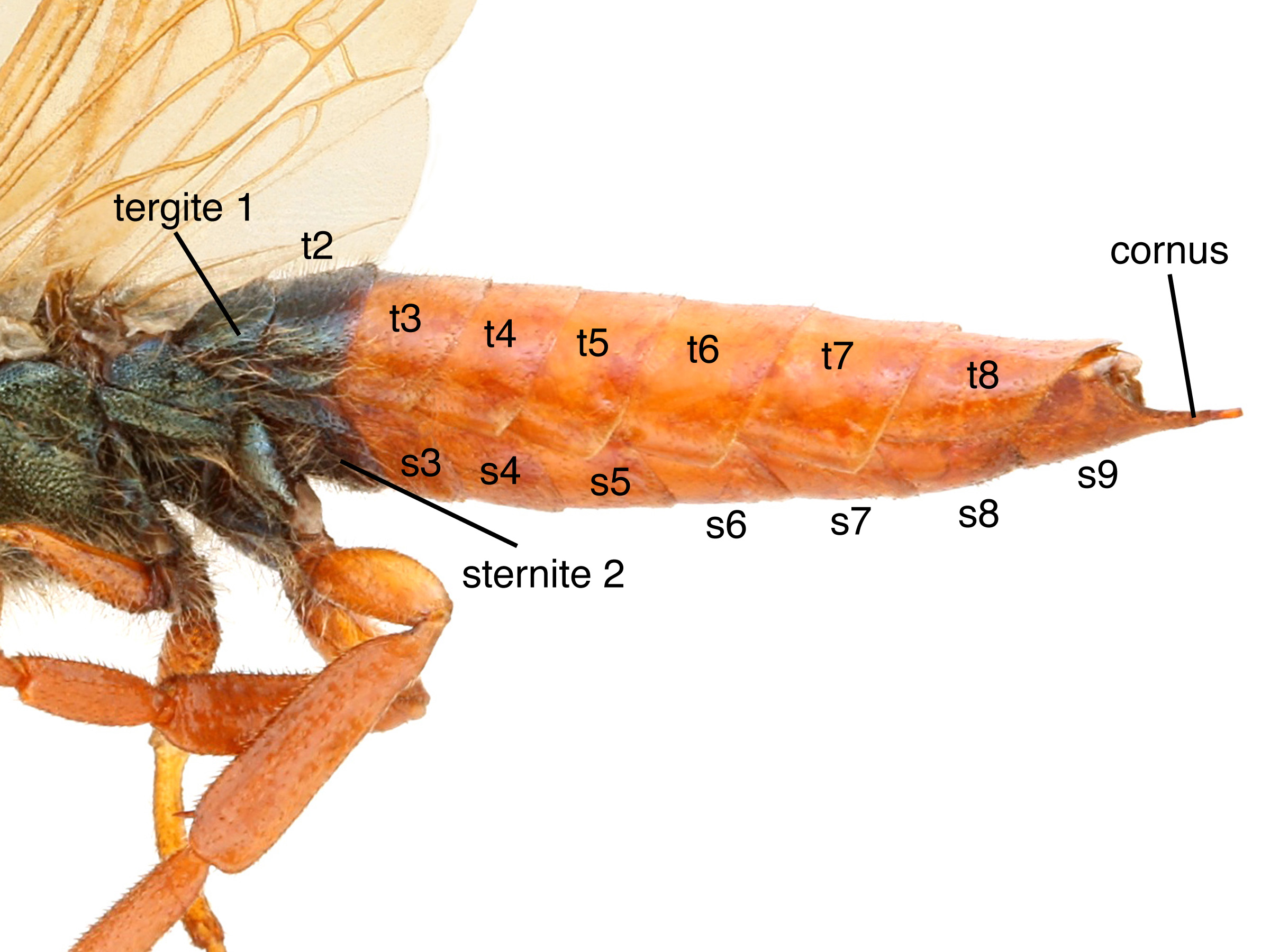 , known as the sinus sexualis. From that location, the male can transfer nutritional secretions to the female. Other Aneugmenus species and one other genus, Neostromboceros, have an observable sinus sexualis, but A. flavipes and NeotropicalNeotropical:
, known as the sinus sexualis. From that location, the male can transfer nutritional secretions to the female. Other Aneugmenus species and one other genus, Neostromboceros, have an observable sinus sexualis, but A. flavipes and NeotropicalNeotropical:
Describing the region of the Western Hemisphere that is tropical, ie. between 30°N and 30°S of the equator; includes southern Mexico, Central America, the Caribbean and South America
 A. merida are the only species where this behavior has been observed. Even more remarkably, no other sawflies are recorded exhibiting courtship activities like this. In A. merida, nuptial feeding is pre-copulatory, and though the timing is not known for A. flavipes, it is likely the same (Smith 2003, Avila-Núñez et al. 2007Avila-Núñez et al. 2007:
A. merida are the only species where this behavior has been observed. Even more remarkably, no other sawflies are recorded exhibiting courtship activities like this. In A. merida, nuptial feeding is pre-copulatory, and though the timing is not known for A. flavipes, it is likely the same (Smith 2003, Avila-Núñez et al. 2007Avila-Núñez et al. 2007:
Avila-Núñez JL, Otero LD, Silma S, and Calcagno-Pisarelli MP. 2007. Life history of Aneugmenus merida Smith (Hymenoptera: Tenthredinidae) in the Venezuelan Andes. Neotropical Entomology 36 (1): 22–027.).
Adults of A. merida in Venezuela also feed as adults on extrafloral nectaries of the host fern. North American species with the same host may also have this behavior (Avila-Núñez et al. 2007Avila-Núñez et al. 2007:
Avila-Núñez JL, Otero LD, Silma S, and Calcagno-Pisarelli MP. 2007. Life history of Aneugmenus merida Smith (Hymenoptera: Tenthredinidae) in the Venezuelan Andes. Neotropical Entomology 36 (1): 22–027.).
World: This genus is known from North and South America, throughout Europe, North Africa, western Asia, eastern Russia, Japan, China, Taiwan, and Southeast Asia (Lacourt 1990Lacourt 1990:
Lacourt J. 1990. Le genre Aneugmenus Hartig 1837 en Afrique du nord (Hymenoptera Tenthredinidae). Bulletin Mensuel de la Socieacute;teacute; Linneacute;enne de Lyon 59 (6): 170-172., Taeger et al. 2010Taeger et al. 2010:
Taeger A, Blank SM, and Liston AD. 2010. World Catalog of Symphyta (Hymenoptera). Zootaxa 2580: 1-1064., Niu and Wei 2013Niu and Wei 2013:
Niu G and Wei M. 2013. Review of Aneugmenus Hartig (Hymenoptera: Tenthredinidae) with description of a new species from China and a key to world species (excluding Neotropical). Entomotaxonomia 35 (3): 221-232.).
North America: Most North American species of Aneugmenus have distinct ranges. Aneugmenus flordidella is known from Florida, A. scutellatus from southern Arizona and northern Mexico, A. nigritarsis from Puebla, San Luis Potosi and the state of Mexico, and A. leucopoda from Guatemala (Rohwer 1911Rohwer 1911:
Rohwer SA. 1911. New sawflies in the collections of the United States National Museum. Proceedings of the United States National Museum 41: 377-411., Smith 2003, Smith 2005Smith 2005:
Smith DR. 2005. Two new fern-feeding sawflies of the genus Aneugmenus Hartig (Hymenoptera: Tenthredinidae) from South America. Proceedings of the Entomological Society of Washington 107 (2): 273-278.). Aneugmenus padi is established in British Columbia, Washington, and Oregon, and A. flavipes occurs in eastern Canada and United States, as far north as Newfoundland, south to North Carolina, and west to Manitoba (Smith 1969eSmith 1969e:
Smith DR. 1969e. Nearctic Sawflies. II. Selandriinae: Adults (Hymenoptera: Tenthredinidae). Technical Bulletin, U.S. Department of Agriculture 1398: 1-48.). The range of A. diversicolor is only described as “Mexico” (Rohwer 1911Rohwer 1911:
Rohwer SA. 1911. New sawflies in the collections of the United States National Museum. Proceedings of the United States National Museum 41: 377-411.).
Map data from: GBIF.org (29 October 2019) GBIF Occurrence Download Aneugmenus
Details about data used for maps can be found here.